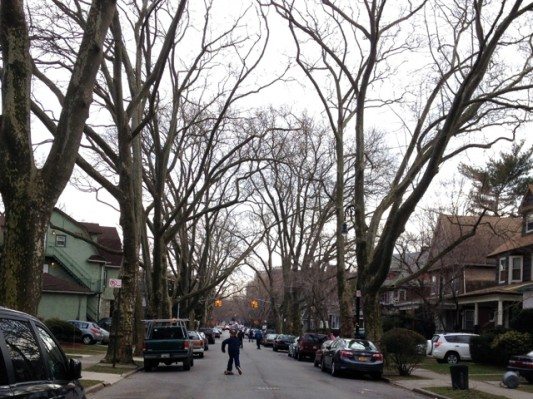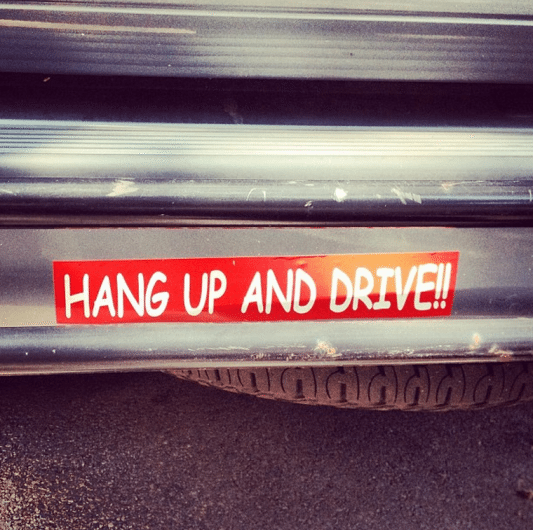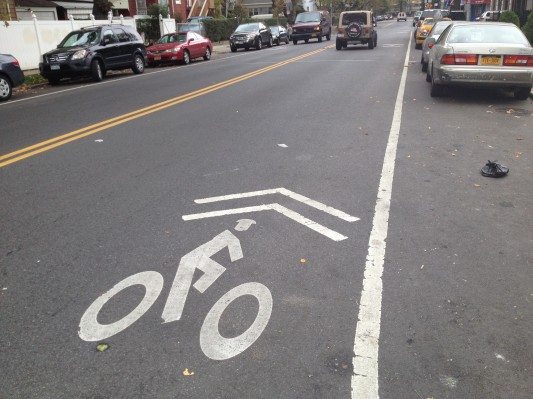Traffic Study Examines Risky Behavior On Community District 14 Streets

Community Board 14 recently posted to their website an extensive report by SUNY Downstate’s Mark W. Hoglund, who surveyed a 141 people about their experiences getting safely around Community District 14, then studied pedestrians, bicyclists, and drivers on local thoroughfares to examine whether certain behaviors were likely to put them in “risky situations.”
The behaviors in question, which were suggested by survey participants, included:
• Bicyclists riding against the direction of traffic, ignoring traffic signals or trying to beat them, riding on the sidewalk, riding without wearing a helmet, or weaving in and out of traffic or riding in the center of the street.
• Pedestrians ignoring traffic signals, using cell phones (talking or texting), or crossing mid-block or coming out between cars.
• Drivers speeding, not yielding the right of way, using cell phones, or going through red lights or trying to make it through yellow lights.
After observing multiple intersections around the district, Hoglund notes that “few truly risky incidents were observed, although examples of the community-identified risk behaviors were plentiful.” He says while he observed no bikers who were at immediate risk of an accident, nearly 3/4 were not wearing helmets, and 18% each rode against traffic and crossed intersections against the light.
“Pedestrians generally crossed against the light only when no oncoming vehicles were close,” Hoglund’s report continues. “Cell phone users observed in crosswalks generally crossed with the lights or when no oncoming traffic was nearby. The greatest risk to pedestrians appeared to be entailed in crossing the street mid-block on busy thoroughfares.
“Speeding by motorists did not appear to be problematic,” he says, “there were few observed instances of driver failure to yield to pedestrians, and no risky situations were observed concerning motor vehicles running red or yellow lights. Some drivers were spotted using cell phones on many different avenues within Community District 14, and the actual prevalence is probably greater than what was observed; nevertheless, no incidents were observed in connection with the cell phone use.”

While most of the people observed did not seem to be in immediate danger as a result of behaviors specified by those surveyed, Hoglund says he did spot many other scary behaviors.
“When the focus shifted to watching for any behaviors which entailed palpable risk in the context of the moment, several risky situations were observed during almost every observation, and many examples were recorded,” says Hoglund, citing “vehicles vying for position while making turns and/or interfering with pedestrians in the crosswalks” and pedestrians standing off the sidewalk at corners as cars turned close to them .
“Wherever there is significant pedestrian and vehicle traffic in Community District 14,” Hoglund says, “one doesn’t have to wait long to see individuals place themselves or others at risk.” He postulates that “safety is compromised because people want, and expect, to get from place to place as quickly as possible. Impatience and being in a hurry seems to be an inherent part of human nature, at least in Brooklyn and New York City.”
Hoglund recommends more traffic calming measures in CB14, including speed bumps, bike lanes, and more traffic signals, but recognizes those changes to be expensive and challenging to implement.

“An alternative approach would be to change people’s attitudes and behaviors, either by imposing regulations such as reducing the speed limit, or by implementing programs or campaigns to educate the public about the benefits of slowing down, being more patient and cooperative, and staying safely out of harm’s way.”
Hoglund suggests achieving this goal through not only lowering speed limits, but as many neighbors have suggested, proper enforcement–as well as encouraging a “slow down” attitude to drivers, pedestrians and bicyclists across a broad age spectrum via Parent Teacher Associations, and in driving courses offered by insurance companies.
Finally, and perhaps most surprisingly especially given its lack of discussion throughout the report, Hoglund suggests banning skateboarding as a mode of transportation.
We’re surprised to read the results of Hoglund’s study, as we see the behaviors he says were rare or nonexistent on a near-daily basis–and we also must wonder if skateboarding is much more hazardous than walking or biking. You can read the full report here, and taking into account what you’ve observed around our area, do you agree with Hoglund, beg to differ, or think other “risky behaviors” should have been studied in the first place?




